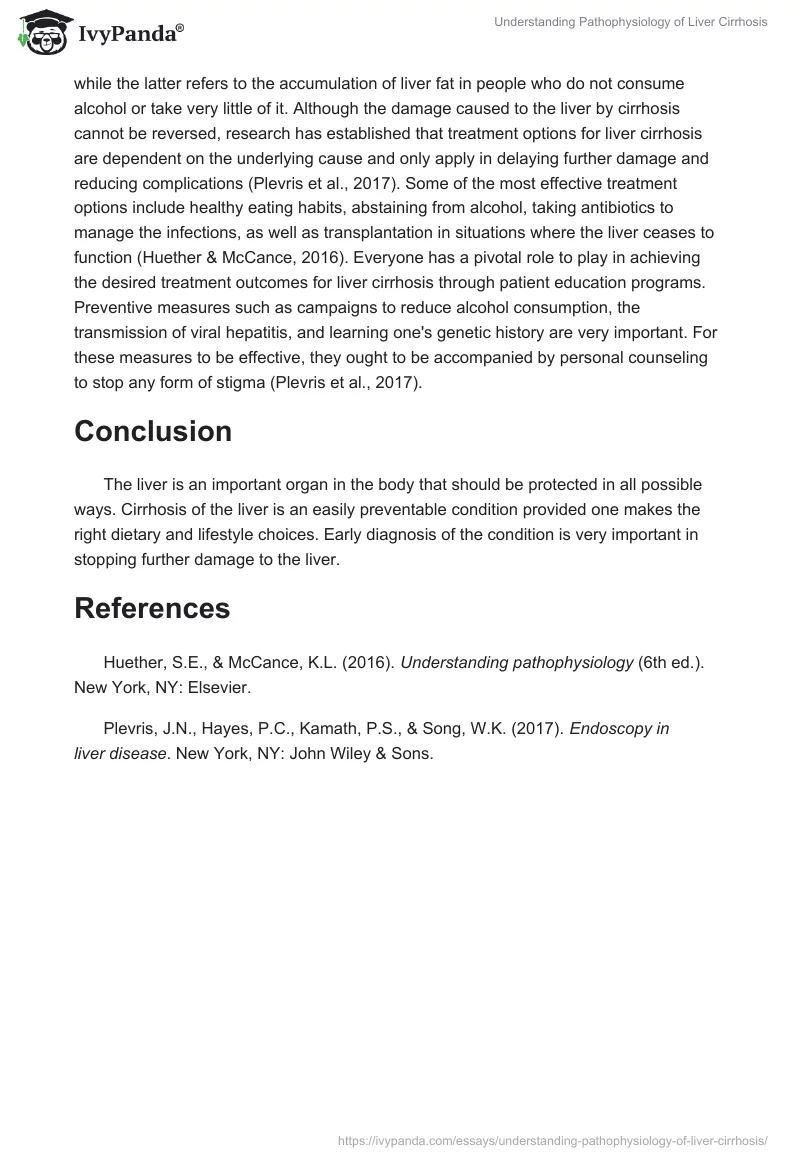Cirrhosis refers to a chronic disease that interferes with the normal functions of the liver. This is an important body organ because it plays a crucial role in synthesizing proteins and detoxification of the body (Huether & McCance, 2016). The pathological feature of this condition is the scar tissue that develops to replace normal parenchyma (Huether & McCance, 2016). This tissue often interrupts the normal flow of blood through the liver, thus leading to a rise in blood pressure levels. Studies have established that it is one of the major life-threatening diseases in the world, thus early detection during the inflammation and fibrosis stages plays a pivotal role in improving patient outcomes (Plevris, Hayes, Kamath, & Song, 2017). The main reason for this is the fact that the damage inflicted on the liver due to cirrhosis cannot be reversed although further harm can be limited.
Discussion
Damage to the liver is not something that can happen overnight because it is mainly caused by habits and lifestyle choices carried out over a prolonged period. Some of the common causative elements associated with liver cirrhosis include obesity, alcohol addiction, genetic digestive disorders, destruction of the bile duct, cystic fibrosis, infections relating to hepatitis B or C, as well as iron buildup in the body (Huether & McCance, 2016). Liver cirrhosis has numerous symptoms that are only experienced by the liver that has suffered extensive damage. They include fatigue, loss of appetite, weight loss, nausea, itchy skin, edema, drowsiness, slurred speech, and redness in the palm of hands among others (Plevris et al., 2017). Notably, women with this condition tend to experience absent periods with no relation to menopause, while men experience loss of sex drive, enlarged breasts, or testicular atrophy.
Some of the common complications associated with liver cirrhosis include portal hypertension, malnutrition, infections, bone disease, increased risk of liver cancer, bleeding, as well as swelling of legs and the abdomen (Huether & McCance, 2016). People suffering from liver cirrhosis are also prone to alcoholic fatty liver disease and non-alcoholic liver disease. The former refers to an increased build-up of fat in the liver, while the latter refers to the accumulation of liver fat in people who do not consume alcohol or take very little of it. Although the damage caused to the liver by cirrhosis cannot be reversed, research has established that treatment options for liver cirrhosis are dependent on the underlying cause and only apply in delaying further damage and reducing complications (Plevris et al., 2017). Some of the most effective treatment options include healthy eating habits, abstaining from alcohol, taking antibiotics to manage the infections, as well as transplantation in situations where the liver ceases to function (Huether & McCance, 2016). Everyone has a pivotal role to play in achieving the desired treatment outcomes for liver cirrhosis through patient education programs. Preventive measures such as campaigns to reduce alcohol consumption, the transmission of viral hepatitis, and learning one’s genetic history are very important. For these measures to be effective, they ought to be accompanied by personal counseling to stop any form of stigma (Plevris et al., 2017).
Conclusion
The liver is an important organ in the body that should be protected in all possible ways. Cirrhosis of the liver is an easily preventable condition provided one makes the right dietary and lifestyle choices. Early diagnosis of the condition is very important in stopping further damage to the liver.
References
Huether, S.E., & McCance, K.L. (2016). Understanding pathophysiology (6th ed.). New York, NY: Elsevier.
Plevris, J.N., Hayes, P.C., Kamath, P.S., & Song, W.K. (2017). Endoscopy in liver disease. New York, NY: John Wiley & Sons.


